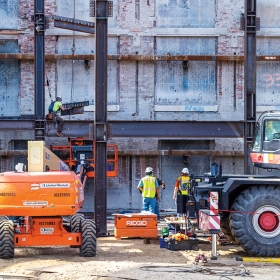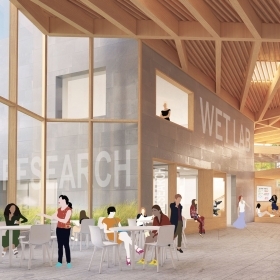As construction workers on the new Science Center prepared to place the last piece of structural steel in the building skeleton, students, faculty, and donors were invited to sign the final beam, which had been painted a bright Wellesley blue.

Photo by Lisa Abitbol
Late in October, community members had the opportunity to write their names in Wellesley’s history—quite literally. As construction workers on the new Science Center prepared to place the last piece of structural steel in the building skeleton, students, faculty, and donors were invited to sign the final beam, which had been painted a bright Wellesley blue. This socially distanced “topping off” ceremony marked a significant construction milestone.
Early in the year, not long before the pandemic sent students home in March, demolition began on the 1920s-era Sage Hall. Its exterior wall, part of the soaring atrium known as “the Focus,” was preserved (above) and is held in place during construction by a massive steel structure and concrete weights.The state-of-the-art complex that is rising behind the wall—between the newly renovated labs in the L-wing and Whitin Observatory—is designed to be fully sustainable, full of light, and easy to navigate. It consists of a series of wings of different heights, to allow for better sight lines to view the southern sky.
Construction was delayed by asbestos abatement in Sage and later by the pandemic. The new Science Center is now slated to open for classes in the spring of 2022. “It’s starting to look like a building,” says Cathy Summa ’83, director of the Science Center. “It’s exciting.”
Watch the construction go up at web.wellesley.edu/video/science.html.


